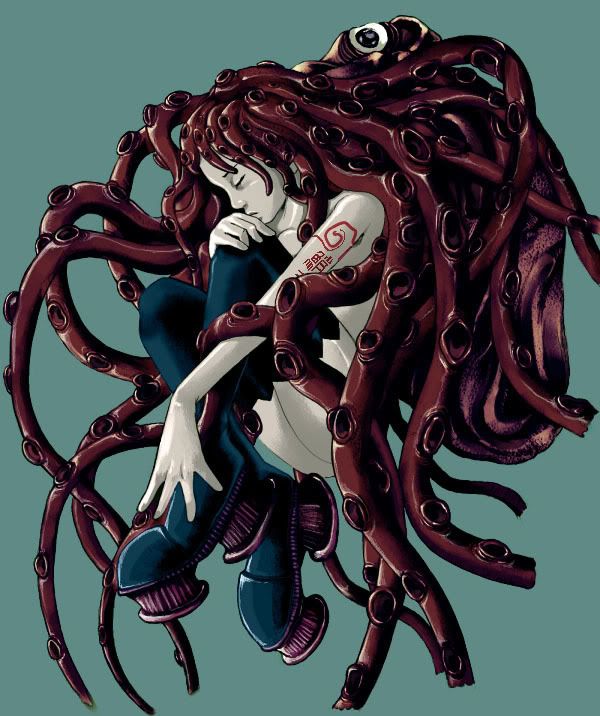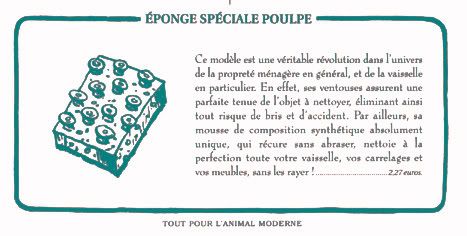Arte y pulpos -Jeremy Forson-
Published Tuesday, October 31, 2006 by Spyder.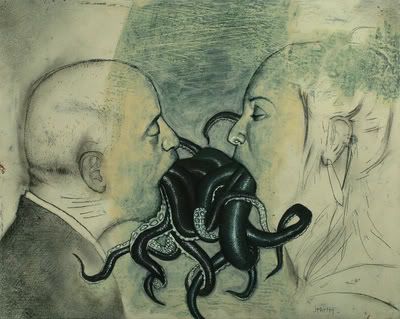
...Estoy cantando
Me descubro extendiendo mi voz como la piel de un animal
que se pone al sereno llena de sal y estacas
estirada en la noche como una mancha...
Efraín Bartolomé
Poeta mexicano nacido en Ocosingo, Chiapas en 1950.Estudió psicología e inició su trayectoria literaria en 1982 con la publicación de «Ojo de jaguar». Posteriormente publicó «Ciudad bajo el relámpago» en 1983, «Música solar» en 1984, «Cuadernos contra el ángel» en 1987, «Mínima animalia» en 1991, «Cantos para la joven concubina y otros poemas dispersos» en 1991, «Cirio para Roberto» en 1993, la edición trilingüe de «Ala del sur» en 1993 y «Partes un verso a la mitad y sangra» en 1997. Gracias a su gran vitalidad poética y a su labor creativa, ha recibido importantes premios literarios entre los que se cuentan el Premio Nacional de Poesía Aguscalientes en 1984, el Premio Nacional de Literatura Gilberto Owen en 1993 y el Premio Internacional de Poesía Jaime Sabines en 1996.
Labels: Artistas
Pulpo -Envases- Tako Chips-
Published Monday, October 30, 2006 by Spyder.
Labels: Envases, Fotografías
Gif -Pulpo monstruoso-
Published Sunday, October 29, 2006 by Spyder.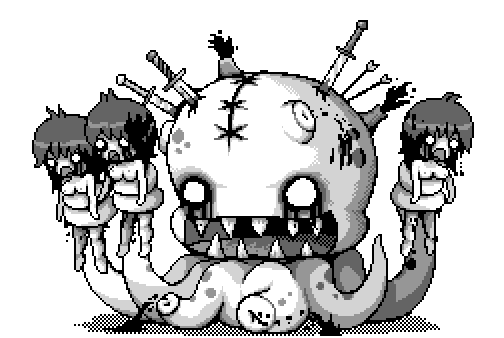
EL CORAZÓN DEL MONSTRUO
Tras de la cacería que ensangrentó los mares
flotaba a la deriva el corazón del monstruo,
hinchado,
tumefacto,
como un peñón de odio extirpado del mundo
que aún roto y cercenado contamina las aguas.
Su carne nauseabunda,
batida por las olas,
exhalaba el hedor de una ciudad sitiada
a la que el enemigo,
la miseria
y las plagas,
han llevado la muerte a sus espesos muros.
Por fin el universo tornaba a su sosiego:
astillas,
remos rotos,
los buitres en el cielo en su cotillón de sombras,
la mortaja del mar meciéndose tranquila.
No obstante, aún se temían
los colmillos y garras del monstruo
que ahora era tan sólo un corazón
y esa carne corrupta,
deforme,
ulcerada,
podía sembrar sin tregua las raíces del mal.
Con un golpe de azada le abrieron el costado
y de esa gran carroña que saturaba el mar
surgió una tenue fuente
de perfumado aroma,
que avanzó entre hediondeces
sin ser asimilada,
como un potente río de corriente muy clara
que se adentra en los mares
sin alterar sus aguas.
Samuel Serrano (Colombia, 1964)
Samuel Serrano Serrano es un escritor colombiano residente en Madrid. Autor de los libros Ritual del recluso y Canto rodado. El poema pertenece al libro inédito Claroscuro del monstruo.
Labels: Gif animados
Amado Nervo -Un pulpo de tentáculos insaciables-
Published Saturday, October 28, 2006 by Spyder.un pulpo de tentáculos insaciables...
Amado Nervo (1870-1919)
Labels: Literatura
Pulpo -Expresiones latinas-
Published by Spyder.

Polypi mentem obtine
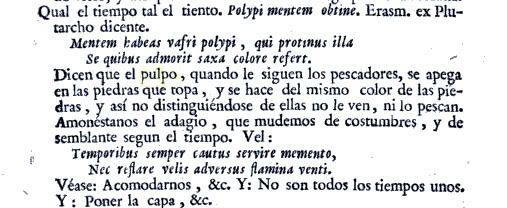
Balbinum polypus agnae delectat
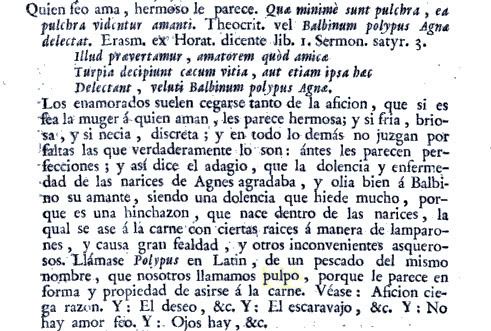
"Refranes, y modos de hablar Castellanos, con los latinos que les corresponden; y la glosa, y explicación de los que tienen necesidad de ella".
Fecha de publicación: 1792
(Un libro con uno de esos títulos que en la actualidad sería impensable)
Labels: Literatura
Arte y pulpos -Ouka Leele- Pulpo's Boulevard (II)
Published Friday, October 27, 2006 by Spyder.
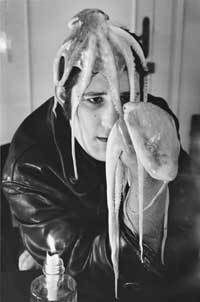
Arte y pulpos -Ouka Leele- Pulpo's Boulevard
Published by Spyder.La exposición lleva por nombre Pulpo’s Boulevard. Lo cual no hace más que constatar la vena pulpera de la artista. Por ello le damos toisón de oro.
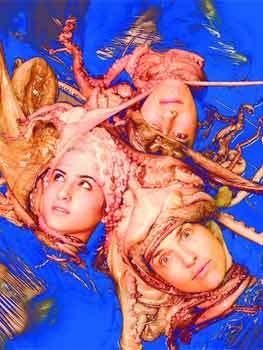
La exposición 'Pulpo´s Boulevard' supone para la artista Barbara Allende, más conocida como Ouka Leele, mirar hacia atrás y hacer una reflexión inédita sobre su propia obra.
Esta exposición, dirigida por Jaime Brihuega y Mónica Carabias, y ubicada en la Sala de Exposiciones Alcalá 31 (sede de la Consejería de Cultura y Deportes), estará abierta al público del 11 de octubre al 12 de noviembre.
'Pulpo´s Boulevard. Ouka Leele en su laberinto' está articulada en dos grandes apartados. Por una parte, se recoge una muestra antológica de los 30 años de oficio de la artista, en la que no faltan imágenes inéditas y que reúne los originales más representativos de su carrera, como su conocida serie 'Peluquería', o sus primeros célebres trabajos en blanco y negro, entre otros. La antología se completa con una selección de sus desnudos y retratos coloreados.
Además de estas obras, la planta baja de la exposición presenta la obra que Ouka Leele ha creado específicamente para esta exposición. Así, se propone al público un recorrido conceptual por el siglo XX en el que la artista reflexiona sobre su propia obra, y el contexto en el que se realizó. Como resultado, la autora obtiene la esencia de la cultura visual del siglo XX, todo ello en torno a un pulpo gigante de ocho metros colgado del techo de la sala.
Noticia sobre la inteligencia de los pulpos
Published Thursday, October 26, 2006 by Spyder.NATALIE ANGIE
Labels: Noticias
Inteligencia de los pulpos -The Octopus Memory-
Published by Spyder.The Octopus Memory
They are wonderful camouflage artists, able to assume almost any shape, even altering the texture and color of their skin to blend imperfectly, invisibly, with the sea floor. They talk to each other and to fish by color signals washing through their satin soft skin. They know all about subterfuge, puffing out a murky cloud of ink like a magician puffs out a plume of smoke to vanish behind. I even saw one throw a decoy crab shell to win a live crab from a determined queen trigger fish. Octopus eat crabs, shrimp, and clams.
Octopus are brilliant learners.
With a little imagination you can teach an octopus nearly any trick at all. A German agricultural expert in Samoa became curious about the flexibility of octopus. How small a hole can an octopus slither through? He set up an aquarium divided by a sheet of clear plastic. A glass tube connected the two halves of the tank. He put a crab in one, an octopus in the other. The Octopus saw the crab, quickly ran its tentacles over the Plexiglas wall, discovered the glass tube and slid through it to get the crab.
Smaller tube. The second time the octopus didn't waste time fiddling around. It immediately slithered through the glass tube. The researcher put in another plastic barrier with a smaller tube, and the octopus oozed through. Then a smaller tube until the hole was just about as small as the diameter of the octopus' eye. He made a movie of his octopus going through the glass tube and it looks like a pink worm with a big eye on one end.
The Seaquarium in Miami Florida had a display of Florida lobsters. The lobsters kept vanishing and the manager thought, perhaps, one of the employees was making off with them. Or maybe somebody was sneaking in over the fence at night and stealing them. The Night watchman himself was one of the suspects and was determined to catch the thief if only to clear himself. Again and again the lobsters vanished but he couldn't catch anyone doing it. One night he went about his rounds as normal and then slipped back into the main display area and waited. After 30 minutes he thought he saw something happening in the lobster tank and he turned on all the lights. A big octopus was in the lobster tank. The watchman ran around to the walkway above the tanks and as he entered the area he saw the octopus lugging its captive lobster along the walkway, hell bent for its own tank. When they checked the octopus tank they found the empty shells of the stolen lobsters buried under the rocks. Octopus can obviously learn new tricks all by themselves.
Where do they store their memories?
Some memories are genetic, recorded in the large, complex DNA molecules found in every octopus cell. These tell the cells how to go from one fertilized egg cell to the billions of cells that form and are an octopus. They store important memories about how a baby octopus should crawl, swim, disguise itself, communicate with rainbows in its skin, mate, reproduce, lay eggs and protect them and die. These are tricks the canny octopus learned over the hundred million years or so it has been prowling the seven seas. Ancient memories.
Then there are very short term memories, such as the ability of a cell to remember conditions existing a fraction of a second before, so it can compare incoming perceptions with the prior condition and thus respond. These are erased almost immediately and involve changes in simple protein structures.
And there are memories that the octopus stores for its rather short (one year) life. The wonderful discoveries each octopus makes during its life are stored in some secret place, maybe in RNA scattered everywhere in the octopus body. They are not passed along to their young. octopus never get to see their own offspring. The female does not eat while guarding her eggs. She dies when they hatch out and swim into the sea.
Thought Transference
There are some very peculiar aspects to memories. Single celled creatures, like protozoa, or bacteria can be taught to respond to certain signals. When the cells divide, the progeny keep the recorded memory.
Scientists in the mid fifties taught flatworms to curl up when a bright light was turned on. The flatworms were cut into hundreds of tiny pieces and fed to untrained flatworms. Yes indeed, the cannibalistic flatworms received and used the memory leading researchers to believe the memories were somehow stored in proteins.
How about this. Take a green sponge and a red sponge. Mash. Separate the cells by straining through a nylon sieve. Mix. The sponge cells change into little amoebas, collect together and form up again into a green sponge and a red sponge.
This is something like a human corporation that is rebuilt even if a fire or bomb destroys the entire physical plant and all the corporate records. The corporation remains because the people, if not destroyed, too, remember a pattern of mutual intercommunications, and can put their act together again. None of the individuals have the complete story, but each knows how to relate with each other to get the job done.
Interesting? Here's another and this is really strange. The ability to do all this remembering, especially genetic remembering, is stored in the DNA molecules. Take a colony of radiation resistant bacteria. Blast them with radiation until they fragment, keep blasting until their DNA molecules fragment. Mix. The bacteria, along with their DNA molecules reassemble themselves. How can this happen if the DNA is supposed to organize the construction of the bacterium? How does DNA, once fragmented, put itself back together again?
The miraculous radiation resistant bacteria are not unique, either. It seems all DNA can repair itself. Again, the system must have a kind of central organizing system to even know part of its coded information is messed up and, it must have some way of repairing the problem correctly and in sequence.
There is only one model that fits these events;
Memory is the result of the flow of information in specific patterns. It easily reforms into these patterns so long as the "concept" remains in the perception, memory, and response of some portion of the whole association.
Labels: Comportamiento
Juguetes para pulpos
Published Wednesday, October 25, 2006 by Spyder.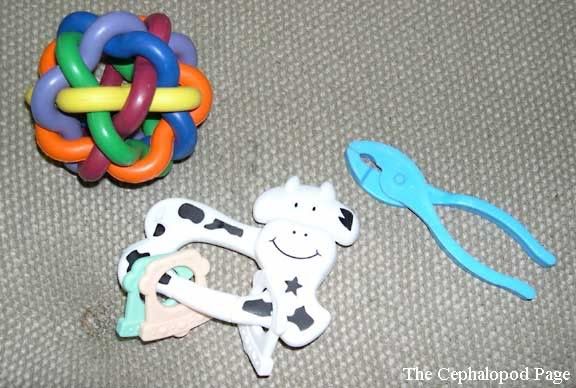
Labels: Comportamiento
Juguetes para pulpos -Brillian Houdinis of the Deep-
Published Tuesday, October 24, 2006 by Spyder. Ya lo decía yo hace unos días que los pulpos se escapaban de sus tanques como niños traviesos, en este artículo se comentan estas escapadas, el motivo es que los pulpos se aburren en sus tanques. Ergo si el pulpo se aburre, es porque es inteligente.
Ya lo decía yo hace unos días que los pulpos se escapaban de sus tanques como niños traviesos, en este artículo se comentan estas escapadas, el motivo es que los pulpos se aburren en sus tanques. Ergo si el pulpo se aburre, es porque es inteligente.By Darragh Johnson
A leading indicator of octopus intelligence is that they get bored.
A leading indicator of human intelligence is that the humans at Washington's National Aquarium have figured out this, despite long-standing prejudice against octopuses: That they are invertebrates, all squish and shape-change, and one of their greatest tricks is squeezing through something that's the dimension of their eye -- which makes them sound like worms. Out of hunger for amusement -- not necessarily food or freedom -- they can maneuver out of tanks whose covers have been held down by 40 pounds of concrete blocks, and climb into the tanks of other sea creatures and eat them. They can die of boredom -- by climbing out, but not finding a tank to climb back in. Perhaps recalling the suicide note of British actor George Sanders: "Goodbye. I am leaving because I am bored."
Hence, while better-behaved angelfish and clams entertain themselves, it is the job of the aquarium staff to entertain octopuses as if they were bright, spoiled and manipulative children demanding attention.
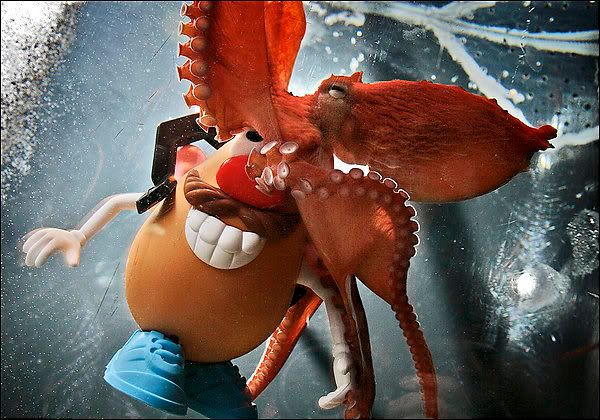 Just now, one of those humans has dropped a green plastic alien action figure into the tank.
Just now, one of those humans has dropped a green plastic alien action figure into the tank."Oooooo," croons the crowd as a 6-month-old, five-pound great Pacific octopus stretches out a long, red arm. She lassos the alien's head and swings it toward her mouth.
"What's he doing with the alien?" worries Patrick Orwin, 9.
Then a pair of big blue feet splashes into the tank. The octopus drops the alien and reaches for the feet, which sink fast. The objects are followed by a brown body, a Tom Selleck mustache, a red Bozo nose and a green plastic ball cap.
"Mr. Potato Head!" a few children squeal, and immediately Shania (who came from Canada and was dubbed Shania Twain by the aquarium's director) hugs herself around him. Minutes pass. The octopus-keeper has hidden smelt inside the plastic potato, but so far, Shania ignores the food. She's more into snuggling.
"You guys!" shouts a boy in the crowd. "Look at that! Look at that !"
Ah, the creepy-crawly creature, the swarming arms, that deep-sea demeanor. This is the bearer of intelligence?
"That was my attitude, too," confesses science writer Eugene Linden, who has written about animal intelligence since the 1970s and had focused, mostly, on the "big-brained" creatures such as apes, dolphins, elephants and whales. "I shared all the prejudices everybody else has."
Then he started hearing octopus stories. Like how they can open screw-top jars and hamster balls and child-proof caps. They can do mazes and learn shapes and distinguish colors and use tools.
"They play," says Jennifer Mather, a psychologist and octopus expert at Canada's University of Lethbridge.
There are even hints that octopuses have a sense of humor, Linden says.
He talks about the finicky octopus who, in a lab in Pennsylvania, was served slightly spoiled shrimp. The octopus refused to finish its dinner, and when the feeding researcher returned to its tank, the octopus made eye contact with her, then meaningfully pushed all the shrimp down the drain.
And Linden talks about the octopus that glided along the seafloor while holding a shell like a helmet over its head, as seen by the former director of the New York Aquarium, who was scuba diving in New England. As Linden writes in his 2002 book "The Octopus and the Orangutan: More True Tales of Animal Intrigue, Intelligence, and Ingenuity," it was as if the octopus were saying: I want to be a mollusk protected by its shell -- and not a mollusk protected by its wits.
"If you don't have a shell to hide in," says octopus-expert Mather, "you better be smart."
"They're really quite beguiling and fun to spend time with," says Linden. "They seem to have a personality."
Their personalities can be so strong that, at the Seattle Aquarium, octopus names describe their characteristics, like "Emily Dickinson," the shy mollusk who always hid; and "Lucretia McEvil," the troublemaker who tore up her tank; and "Leisure Suit Larry," who, notes Seattle Aquarium biologist Roland C. Anderson, "would have been arrested for sexual assault because his arms were all over you."
"Look!" chirps a mother, Stephanie Sanders. "She's got Potato Head glued to the wall!"
The crowd in front of Shania's tank keeps growing: About a dozen people jostle for a better view, and small children squeeze between the adults and push their hands and faces to the glass.
Shania lets go of Mr. Potato Head. Rick Quintero, an aquarist, herpetologist and Shania's keeper and personal enrichment tutor, dips a hand into her tank. He's holding an inch-long slice of smelt. Ignoring the fish, she grabs hold of Quintero's hand and doesn't let go, even when he starts to pull away. He nearly lifts the five-pound animal out of the water.
"Wow -- look at the suction on those limbs!" Patrick Orwin says.
An 8-year-old named Mary Mills Lochala starts giggling. "The octopus is tickling him!"
Eventually the day's class ends. Shania has played with a chartreuse hamster ball, has plucked the mustache from Mr. Potato Head's face and is still holding on to his Bozo nose. She hasn't eaten much, so Quintero leaves behind the toys in which her food is hidden.
Shania's tank is kept much dimmer than others at the aquarium, lest too much light make her nervous. Octopuses have been around since the dinosaurs and can seem more primitive than ancient or wise. They're capable of lifting four times their body weight -- a feat that screams muscle beach, not ivory tower. They change color.
Ask Quintero exactly what shade of red she is, and he answers: "She'll make a liar out of you: As soon as you call her one color, she'll change." And she does. Just before she starts playing with the alien and Mr. Potato Head, and before the thick crowd has gathered around her tank, Shania is a solid, vivid coral-red. But by the time she's cuddling with the Potato, she's turned an elaborately patterned white-and-crimson polka dot.
Replacing the Velcro-sealed top to Shania's tank, Quintero weights it with concrete blocks. The children remain pressed against the window. A 7-year-old from Michigan named Jill Neumann says, almost to herself: "That's a sweet octopus. I would like it for a pet."
Her mother, Jeanne Neumann, reacts quickly: "Uh, nooo thank you," she says. "No."
Quintero reappears in front of Shania's tank, in his blue National Aquarium staff polo shirt. He is talking about how Shania's predecessor, a shy male, spent about 80 percent of his time hiding within the tank's rocks, while Shania spends 80 percent of her time in plain view. It's a question of personality. She will soon move to a new and bigger tank, here in the basement of the Commerce Building, and they expect her to grow to about 30 or 40 pounds.
Another mother, Julia Helveston, turns away from the tank and says to Quintero, "They're smart, aren't they?"
He beams. Shania is his girl -- the smartest in the aquarium. Other animals get attention and enrichment, too, but it's nothing like what she gets.
Once a week, the two alligators are thrown some big leaves of lettuce and hundreds of crickets -- stuff that glints and moves and gives the animals an excuse to attack something that isn't the other alligator. But there it's aggression, not intelligence or boredom, that demands attention.
As Quintero says, "Not every tank gets Mr. Potato Head.
Labels: Comportamiento
Octopuses -Master Escape Artists-
Published by Spyder.Octopuses: Master Escape Artists
Lucy A. Snyder
Being such highly intelligent creatures, octopuses are master escape artists, and can be hard to keep in an aquarium if they want out. I've known a couple of people who've gotten a small octopod for their home saltwater aquarium, only to find the creature dead and dried-up on the floor after it pried off the tank lid and crawled out in the night. One acquaintance of mine found his little octopod dead of electrocution after it escaped from its tank and made the mistake of probing a socket on a nearby power strip with one of its damp tentacles.
My marine biology professor from my undergrad college once had a laboratory job where they often kept octopuses. He learned a simple technique for convincing the new octopus that, yes, it really wanted to stay put in the aquarium.
He'd put the new octopus in the tank, do some odds and ends in the lab for a few minutes, then leave the room and turn out the lights. He'd wait outside until he heard the telltale, sodden slap that mean the octopus had staged a jailbreak and had hit the floor. He'd wait one minute, then go back into the lab and put the octopus back in the tank.
He'd repeat the process, the next time waiting three minutes. And on the third time, he waited a whole five minutes before rescuing the miserable, sticky, dust-bunny-covered octopus from the lab floor, rinsing it off, and placing it back in the aquarium.
After that third time, he told me, an octopus wouldn't try to escape again. In fact, he sometimes had to work hard to get it out if it needed to be examined or transferred to a new tank so the old one could be cleaned.
Labels: Humor
Bertolt Brecht y los dos centavos
Published Monday, October 23, 2006 by Spyder.PEACHUM. — ¿Dónde?
SEÑORA PEACHUM. — En el Hotel del Pulpo.
PEACHUM. — ¿Capitán? ¿Hotel del Pulpo? A ver, a ver, a ver...
(Eso digo yo que a ver, a ver... que a ver cómo esta el cambio del pulpo en la obra de Bertold Brech: Die Dreigroschenoper, que según la traducción puede ser a dos centavos, tres centavos o incluso tres peniques)
Bertolt Brecht (1898-1956)
Nacido en Augsburgo, Alemania, estudió filosofía y medicina en la Universidad de Munich. Sus primeras obras muestran la influencia del expresionismo, el principal movimiento dramático de la época. En 1928, escribió un drama musical, La ópera de los dos centavos, cáustica sátira del capitalismo que se convirtió en el éxito teatral más importante de Brecht. Se estrenó en 1928 en Berlín. La preocupación por la justicia fue un tema fundamental en toda su obra. Durante este periodo inicial de su carrera, Brecht dirigía a los actores y empezó a desarrollar la teoría de técnica dramática conocida como teatro épico. Salió de Alemania tras el ascenso de Hitler y, tras pasar por Dinamarca, Suecia y Finlandia, se instaló en California en 1941. Interrogado por el Comité de Actividades Anti Estadounidenses, en 1948 huyó a Europa. En 1949 se estableció en Berlín Este, donde permaneció hasta su muerte. Durante esos años de exilio produjo algunas de sus mejores obras: La vida de Galileo Galilei (1938-1939), Madre Coraje y sus hijos (1941), que consolidaron su reputación como importante dramaturgo. Murió el 14 de agosto de 1956 en Berlín.
Labels: Literatura
Mi único tentáculo
Published by Spyder.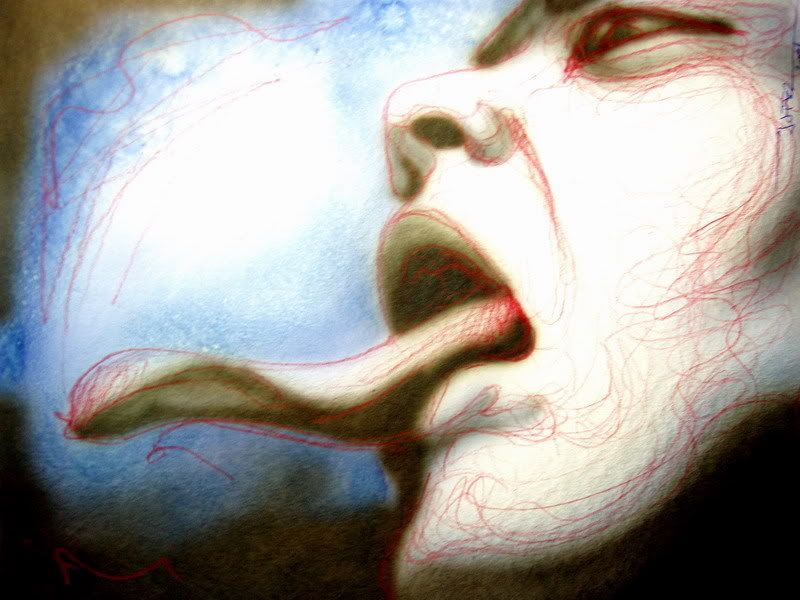
B. Wrightson, Ashley Wood y Chichoni se cuentan entre sus influencias más directas. Se decanta por el aerógrafo, pero también hace amplio uso de óleo, lápiz y tinta, amén del inevitable ordenador. Estudió en la Facultad de Bellas Artes de Sevilla, ha recibido varios premios y participado en multitud de exposiciones por toda Andalucía y parte del extranjero. En la actualidad vive en Alemania.
Labels: Humor
Arte y pulpos -Bah-
Published Sunday, October 22, 2006 by Spyder.Pulpos -Curiosidades- Construcciones enlatadas-
Published Saturday, October 21, 2006 by Spyder.
Fox & Fowle Architects, P.C., New York, NY
The water is upside-down blue Jell-O cups.
Labels: Curiosidades
Noticias -Saturado el mercado del pulpo en el Yucatán-
Published Friday, October 20, 2006 by Spyder.viernes, 20 de octubre de 2006
Las congeladoras están saturadas del molusco. (Julio Jiménez)
Grandes cantidades de pulpo se han estado capturando en estos días.
Derrama de más de $100 millones/ Unas 2,000 ton del molusco desplazadas a mercados internacionales
PROGRESO, Yucatán, 19 de octubre.- Un promedio de 2,000 toneladas se han desplazado al mercado internacional que ha generado una derrama económica de más de 100 millones de pesos.
Pulpos y Graffitis (IV) -Octopi triumphs!-
Published Thursday, October 19, 2006 by Spyder.Si vas por New York, aún encontrarás en las más insospechadas esquinas la firma del fantasma. El fantasma ¿cómo no? presenta una sospechosa forma pulpera.
Y es que el pulpo también ha puesto sus tentáculos en la gran manzana.

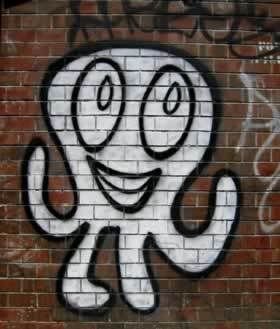
Labels: Graffitis
Help Save The Tree Octopus From Extinction
Published Wednesday, October 18, 2006 by Spyder.¿Pero que me dirían de pulpos que vivieran fuera del agua? ¿Oyeron alguna vez hablar de los Pulpos árbol? Una especie que sólo vive en el mar en sus años jóvenes, mientras que posteriormente puede vivir acumulando la humedad de los bosques.
Pues bien voy a dejar un artículo sobre ellos muy divertido, pero antes de liarles con este pulpo anfibio, les desvelo que todo es una inmensa broma que ha llenado páginas y páginas de internet. Así que mi consejo es que no vayan a los bosques a intentar pescar alguno...
The Pacific Northwest Tree Octopus
(Endangered)
Help Save The Tree Octopus From Extinction!
About The Pacific Northwest Tree Octopus
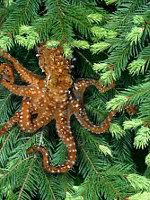 The Pacific Northwest tree octopus (Octopus paxarbolis) can be found in the temperate rainforests of the Olympic Peninsula on the west coast of North America. Their habitat lies on the Eastern side of the Olympic mountain range, adjacent to Hood Canal. These solitary cephalopods reach an average size (measured from arm-tip to mantle-tip,) of 30-33 cm. Unlike most other cephalopods, tree octopuses are amphibious, spending only their early life and the period of their mating season in their ancestral aquatic environment. Because of the moistness of the rainforests and specialized skin adaptations, they are able to keep from becoming desiccated for prolonged periods of time, but given the chance they would prefer resting in pooled water.
The Pacific Northwest tree octopus (Octopus paxarbolis) can be found in the temperate rainforests of the Olympic Peninsula on the west coast of North America. Their habitat lies on the Eastern side of the Olympic mountain range, adjacent to Hood Canal. These solitary cephalopods reach an average size (measured from arm-tip to mantle-tip,) of 30-33 cm. Unlike most other cephalopods, tree octopuses are amphibious, spending only their early life and the period of their mating season in their ancestral aquatic environment. Because of the moistness of the rainforests and specialized skin adaptations, they are able to keep from becoming desiccated for prolonged periods of time, but given the chance they would prefer resting in pooled water.An intelligent and inquisitive being (it has the largest brain-to-body ratio for any mollusk), the tree octopus explores its arboreal world by both touch and sight. Adaptations its ancestors originally evolved in the three dimensional environment of the sea have been put to good use in the spatially complex maze of the coniferous Olympic rainforests. The challenges and richness of this environment (and the intimate way in which it interacts with it,) may account for the tree octopus's advanced behavioral development. (Some evolutionary theorists suppose that "arboreal adaptation" is what laid the groundwork in primates for the evolution of the human mind.)
Reaching out with one of her eight arms, each covered in sensitive suckers, a tree octopus might grab a branch to pull herself along in a form of locomotion called tentaculation; or she might be preparing to strike at an insect or small vertebrate, such as a frog or rodent, or steal an egg from a bird's nest; or she might even be examining some object that caught her fancy, instinctively desiring to manipulate it with her dexterous limbs (really deserving the title "sensory organs" more than mere "limbs",) in order to better know it.
Tree octopuses have eyesight comparable to humans. Besides allowing them to see their prey and environment, it helps them in inter-octopus relations. Although they are not social animals like us, they display to one-another their emotions through their ability to change the color of their skin: red indicates anger, white fear, while they normally maintain a mottled brown tone to blend in with the background.
The reproductive cycle of the tree octopus is still linked to its roots in the waters of the Puget Sound from where it is thought to have originated. Every year, in Spring, tree octopuses leave their homes in the Olympic National Forest and migrate towards the shore and, eventually, their spawning grounds in Hood Canal. There, they congregate (the only real social time in their lives,) and find mates. After the male has deposited his sperm, he returns to the forests, leaving the female to find an aquatic lair in which to attach her strands of egg-clusters. The female will guard and care for her eggs until they hatch, refusing even to eat, and usually dying from her selflessness. The young will spend the first month or so floating through Hood Canal, Admiralty Inlet, and as far as North Puget Sound before eventually moving out of the water and beginning their adult lives.
Why It's Endangered
Although the tree octopus is not officially listed on the Endangered Species List, we feel that it should be added since its numbers are at a critically low level for its breeding needs. The reasons for this dire situation include: decimation of habitat by logging and suburban encroachment; building of roads that cut off access to the water which it needs for spawning; predation by foreign species such as house cats; and booming populations of its natural predators, including the bald eagle and sasquatch. What few that make it to the Canal are further hampered in their reproduction by the growing problem of pollution from farming and residential run-off. Unless immediate action is taken to protect this species and its habitat, the Pacific Northwest tree octopus will be but a memory.
The possibility of Pacific Northwest tree octopus extinction is not an unwarranted fear. Other tree octopus species -- including the Douglas octopus and the red-ringed madrona sucker -- were once abundant throughout the Cascadia region, but have since gone extinct because of threats similar to those faced by paxarbolis, as well as overharvesting by the now-illegal tree octopus trade.
The history of the tree octopus trade is a sad one. Their voracious appetite for bird plumes having exhausted all the worthy species of that family, the fashionistas moved on to cephalopodic accoutrements during the early 20th Century. Tree octopuses became prized by the fashion industry as ornamental decorations for hats, leading greedy trappers to wipe out whole populations to feed the vanity of the fashionable rich. While fortunately this practice has been outlawed, its effects still reverberate today as these millinery deprivations brought tree octopus numbers below the critical point where even minor environmental change could cause disaster.
How You Can Help
Here are a few things that you can do to help save the Pacific Northwest tree octopus:
Write your representatives to let them know that you are concerned and that you feel the tree octopus should be included on the Endangered Species List and given special protection.
Help build awareness of the tree octopus by telling your friends and co-workers.
Place a tentacle ribbon on your website.
Participate in tree octopus awareness marches. You can demonstrate their plight during the march by having your friends dress up as tree octopuses while you attack them in a lumber jack costume.
Pamphlet your neighborhood. Tentacle ribbons make excellent doorknob hangers.
Join and donate to an organization committed to conservation, such as Greenpeas.
Boycott companies that use non-tree-octopus-safe wood harvesting practices.
Sign the petition! -- nothing activates activity like an Internet petition.
Tree Octopus Research
Please see our Tree Octopus Sightings page for additional photos and behavioral research as they become available. [Updated 2005-04-28]
Links To A Better Tomorrow
More About Cephalopods:
The Cephalopod Page - Scientific information about these wonderful mollusks.
The Octopus News Magazine Online - An online magazine about anything and everything pertaining to octopuses, squids and cephalopods.
2006 Cephalopod International Advisory Council Symposium - To be held in Hobart, Australia. Topic: "Cephalopod Life-cycles: biology, management & conservation."
Other Animals of Interest:
Save The Mountain Walrus - Another endangered Northwest creature that needs our help. (Original site down, link is to Archive.org mirror)
Save The Manhattan Beach Mottled Roach - Save one roach today, that tomorrow we may save millions!
Rock Nest Monster - Known only from its rocky nests and porcelean-like eggs, Cryptogorgo petronidus is so endangered that existential environmentalists wonder if it ever existed at all.
Giant Palouse Earthworm (Driloleirus americanus) - This threatened earthworm is native to the Palouse prairies of Washington and Idaho. They can grow up to three feet in length, are pinkish-white, and smell of lilies.
The Red Crabs of Christmas Island - Once every year, 120 million of these forest crabs migrate en masse from their inland burrows to the sea to spawn. Along the way, over a million are crushed by traffic and many die of dehydration crossing deforested land. The offspring of those that survive then have to contend with super-colonies of yellow crazy ants, introduced to the island by the thoughtless actions of Man.
Conservation Organizations
Greenpeas.org - Greenpeas is working to save the world from humans.
World Conservation Union - An international organization whose mission is "To influence, encourage and assist societies throughout the world to conserve the integrity and diversity of nature and to ensure that any use of natural resources is equitable and ecologically sustainable."
The Wildlife Fund - The WWF works to preserve genetic, species, and ecosystem diversity throughout the world.
UNEP World Conservation Monitoring Centre - An office of the UN that provides information for policy and action to conserve the living world.
People for the Ethical Treatment of Pumpkins - How many pumpkins must be sacrificed every year to decorate our houses and keep our bellies filled with pies before we realize the error of our ways? Too many, it seems!
Labels: Humor
Arte y pulpos -Deborah Brown-
Published Tuesday, October 17, 2006 by Spyder.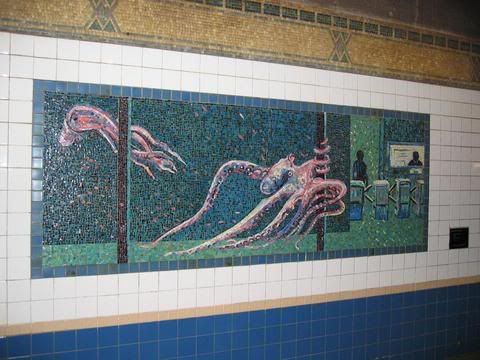
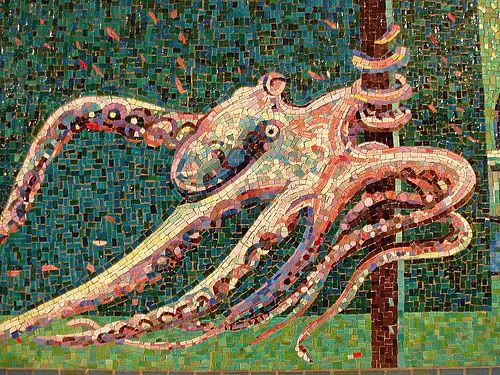
Country: United States
City: New York
System: New York City Transit
Location: Houston Street
Line: IRT West Side Line
Artwork: Platform Diving, Deborah Brown (1994).
Pulpos y películas -Le poulpe-
Published Monday, October 16, 2006 by Spyder. Le poulpe
Le poulpeRéalisateur : Charles Gassot Acteur(s) : Jean-Pierre Darroussin, Clothilde Courau Genre : Comédie
Ya hablamos aquí de este personaje creado por Jean Bernard Pouy, pues bien esta película no deja de ser una adaptación para la gran pantalla.
Gabriel Lecouvrer, alias el Pulpo, no ha conseguido aclarar su última investigación, por lo que decide tomar un descanso a su pueblo natal, en una pequeña ciudad portuaria, con su compañera. Una vez allí, descubriran que la tumba donde descansan sus padres ha sido profanada. Las vacaciones del pulpo acaban de finalizar...
La película creo que aún no ha sido doblada al castellano.
Labels: Cine
Arte y pulpos -Keith Louise Judd-
Published Sunday, October 15, 2006 by Spyder.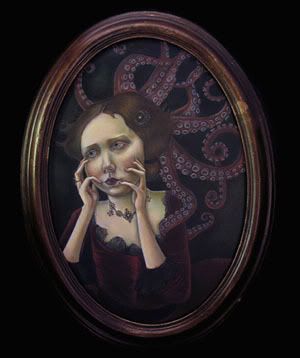
Kelly Louise Judd spends a great deal of her time creating paintings, dolls, and jewelry. Victorian illustration, fairy tales, abnormal psychology, and Northern Renaissance art are a few of the things she is inspired by.
Kelly Louise received a B.F.A. from the Kansas City Art Institute in 2002, she continues to live in Kansas City where she works in her studio full time.
Labels: Artistas
Cocina -Pulpo con gambas-
Published by Spyder.Pulpo (400 gramos)
Gambas peladas (400 gramos)
4 dientes de ajo en filetes
4 trocitos de guindilla
Una ramita de perejil
200 gramos de aceite de oliva
Un pellizco de sal gorda
Pimentón dulce
Elaboración
Cogemos cuatro cazuelas como para gambas al ajillo. Las ponemos al fuego sobre la plancha, echamos el aceite y cuando el aceite esté bien caliente ponemos el ajo en filetes y las guindillas. Cuando empiecen a dorar ponemos las gambas y a continuación el pulpo cocido, cortadito en trozos. Le ponemos la sal gorda, el pimentón, el aceite y el perejil. Cuando estea la gamba hecha lo retiramos y ya está rico para comer.
Fuente: Chef Casi Mera
Labels: Gastronomía, Recetas
Accessoires pour poulpes
Published Saturday, October 14, 2006 by Spyder.El blog de Poulpy
Published by Spyder.Para los que sepan francés, aquí va el curioso blog de Le Poulpe
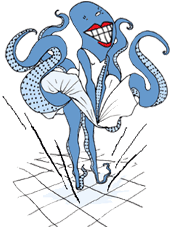
Tout fout le camps moi je vous le dit mesdames, messieurs.
Franchement je ne veux pas tomber dans la nostalgie la plus ville mais, bon, avouons le nous : ou est passée le Poulpe? Je parle bien sur du vrai Poulpe, celui qui nous aguichait de ses tentacules sensuelles, ventousant notre attention avec les vraies questions que nous nous posons :
Quelle proportion de femmes avale?Si oui, le font elles avec appétit ?Si oui, où se cachent elles et sont elles en ligne sur MSN ?Si oui pourquoi n’ai-je pas leur adresse Hotmail ?
Bref une multitude de questions vraies et existentielles, qui relèguent Sartre au placard et Camus au platane.
Le Poulpe actuel est à l’Octopode de jadis ce que le surimi est au crabe.
Alors chers lecteurs et fans, je vous convie à ma grande conférence débat
« Poulpy n’aurait elle pas perdu plus que du poids ?»
Qui se tiendra au sauna mixte des thermes de Grimbergen
PAF: 10 euro, gratuit avant 19h et pour les femmes à partir de 90 c
Labels: Blogs, Curiosidades
Oliver Sacks y el pulpo como animal de compañía.
Published Friday, October 13, 2006 by Spyder.Esta historia se cuenta en el el libro de memorias de infancia de Oliver Sacks: El tio Tungsteno. Recuerdos de un químico precoz.
Oliver Sacks (9 de julio de 1933, Londres) es neurólogo. Ha escrito importantes libros sobre sus pacientes. Se considera seguidor de la tradición, propia del s. XIX, de las «anécdotas clínicas» (historias de casos clínicos contadas siguiendo un estilo literario informal). Su ejemplo favorito es The mind of the mnemonist, de Alexander Luria.
Se licenció en el Queen's College de Oxford y se doctoró en neurología en la Universidad de California. Vive en Nueva York desde 1965. Actualmente es profesor clínico de neurología en el Albert Einstein College of Medicine, profesor adjunto de neurología en la School of Medicine de la Universidad de Nueva York y neurólogo de consulta para las Hermanitas de los pobres. Ejerce en la ciudad de Nueva York.
Sacks describe sus casos con poco detalle clínico, concentrándose en las experiencias del paciente. En una de sus historias (Con una sola pierna) él es el protagonista. Algunos de los casos son incurables, o casi, pero los pacientes consiguen adaptarse a sus situaciones de distintos modos.
En su libro más conocido, Despertares (del cual se hizo una película que lleva el mismo título), relata sus experiencias usando la nueva droga L-DOPA en afectados por la epidemia de encefalitis letárgica acaecida en los años 1920. También fue el tema de la primera película hecha para la serie documental Discovery de la BBC.
En otros de sus libros describe casos del síndrome de Tourette y los efectos de la enfermedad de Parkinson. El relato principal de El hombre que confundió a su mujer con un sombrero versa sobre un hombre con agnosia visual, que también fue el personaje protagonista de una ópera de Mychael Nyman presentada en 1987. La historia Un antropólogo en Marte, que forma parte del libro de mismo nombre, trata de Temple Grandin, una profesora que padece el síndrome de Asperger. Las obras de Sacks han sido traducidas a 21 idiomas.
Libros
• Migraña (1970)
• Despertares (1974)
• Con una sola pierna (1984) (La experiencia de Sacks al perder el control de una pierna debido a un accidente)
• El hombre que confundió a su mujer con un sombrero (1985)
• Veo una voz (1989) (Cultura sorda y lenguaje de signos)
• Un antropólogo en Marte (1995)
• La isla de los ciegos al color (1997) (Ceguera congénita total al color en una sociedad insular)
• El tío Tungsteno: recuerdos de un químico precoz (2001)
• Diario de Oaxaca (2002)
Ensayos
• El ojo de la mente
Labels: Literatura
El blog de Martín
Published Thursday, October 12, 2006 by Spyder.INSTRUCCIONES PARA LEER ESTE BLOG: este blog debe empezar a leerse por el principio. Es decir al capítulo 1 lo sigue el 2, al 2 el 3, y así sucesivamente hasta el 4.
Vaya, que nuestro amigo argentino sin duda es cortazariano.
El blog está hecho por Martín Monreal. Copio su perfil.
Según sus padres y otros confabuladores,nació el 22 de octubre de 1976 en Buenos Aires, Argentina. Puede ser. Habrá que ver. Lo que es cierto es que dormitó tres años en la facultad de Letras, hasta que fue descubierto (no por editores ni productores, sino por el portero) y maltratado acorde. Con ese bagaje de experiencias a cuestas (y por seguir a una chica) en 1999 se fue a Nueva York, en donde desempeñó algunas de las tareas más viles que le pueden ser deparadas a un ser (humano o no): desde lavaplatos en un restaurante del Rockefeller Center hasta asistente en una agencia literaria. Estudió fotografía y animación con diverso grado de éxito y/o fracaso y/o ambos. Paseó perros por las calles de Brooklyn. En 1994 recibió una mención de honor en el concurso organizado por el CACyF. Hay diploma que lo comprueba. En el 2003 algunos de sus poemas fueron premiados y publicados por Honorarte. En general no envía cosas a concurso. Por vago. Ahora lo trasladan en secreto de un lugar a otro debido al alto valor de los manuscritos a los que tiene acceso para la manutención de este blog. No se sabe dónde está en el presente. Probablemente oculto en un búnker bajo Plaza San Martín.
A veces pienso que deberíamos agruparnos bajo algún tipo de emblema, una de esos pequeños símbolos que se ponen en los laterales del blog. ¡Y poder hacer convenciones pulperas una vez al año, donde todos acudiríamos con un pulpo de peluche sobre nuestras cabezas!
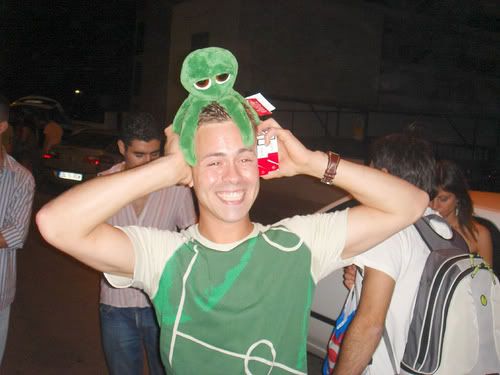
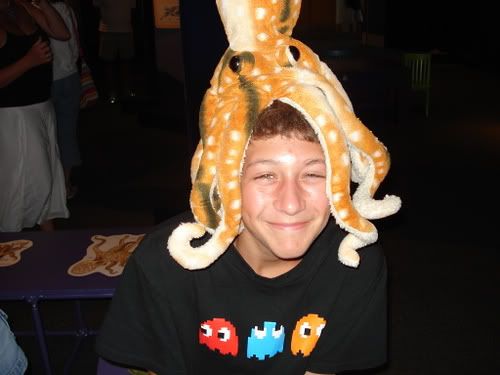
Además no hay duda que un pulpo en la cabeza hace a las personas más felices. Podría ser un buen slogan: “pon un pulpo en tu cabeza”. Observen las caras de felicidad que destilan los fotografiados…
Labels: Blogs, Curiosidades
Pulpos en un acuario -Octopus antics-
Published Wednesday, October 11, 2006 by Spyder.Octopuses are interactive, intelligent and appealing. Jason Scott of The Water Zoo explains the difficulties inherent in keeping these specialised cephalopods.
Jason Scott
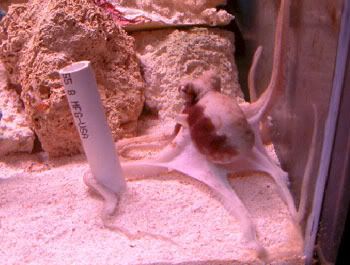
Jason Scott is Practical Fishkeeping's Equipment Answers expert. He owns and manages The Waterzoo in Peterborough, which was voted one of the UK's Top 40 Shops by readers of this magazine. Jason has kept and bred fish for over 25 years and is particularly experienced with unusual marine and freshwater fishes, as well as inverts and aquarium technology.
Labels: Comportamiento
Pulpos en un acuario -An octopus in the home aquarium-
Published by Spyder. Si está planteándose ponerse un acuario en su casa con algunos peces, tal vez sea hora de plantearse una nueva posibilidad menos común, pero puede que más atractiva. ¿Qué le parecería tener un pulpo en un acuario casero?
Si está planteándose ponerse un acuario en su casa con algunos peces, tal vez sea hora de plantearse una nueva posibilidad menos común, pero puede que más atractiva. ¿Qué le parecería tener un pulpo en un acuario casero?  Some of the octopus's remarkable abilities include the capability to expel ink and to change skin texture and apparent size. They are able to jettison water through their siphon by contracting their mantel to provide quick thrust. They have well developed eyes and an efficient closed circulatory system. Octopuses have surprisingly strong but sensitive suckers on their eight arms. Some octopuses make 'speculative attacks' on rocks hoping to flush out prey that might be hiding beneath. Others use their bodies as cast nets and 'parachute' onto prey to trap them. There are reports of octopuses dropping rocks in between the open shells of bivalves, preventing the shell from closing and enabling an easy kill (Lane).
Some of the octopus's remarkable abilities include the capability to expel ink and to change skin texture and apparent size. They are able to jettison water through their siphon by contracting their mantel to provide quick thrust. They have well developed eyes and an efficient closed circulatory system. Octopuses have surprisingly strong but sensitive suckers on their eight arms. Some octopuses make 'speculative attacks' on rocks hoping to flush out prey that might be hiding beneath. Others use their bodies as cast nets and 'parachute' onto prey to trap them. There are reports of octopuses dropping rocks in between the open shells of bivalves, preventing the shell from closing and enabling an easy kill (Lane). Labels: Comportamiento
Chiste -Un pulpo en la cabeza-
Published Tuesday, October 10, 2006 by Spyder.Labels: Humor
Noticia -Boy survives blue ringed octopus bite-
Published Monday, October 09, 2006 by Spyder.By Rosemary Desmond
October 09, 2006
Vía The Australian News
A Toddler who was bitten by a deadly blue ringed octopus after he picked it up and played with it has lived to tell the tale.
Anthony Cerasa spent Saturday night on life support in Mater Hospital after being bitten by the octopus while playing with his brother in the shallows at Suttons Beach near Redcliffe, north of Brisbane.
He was rushed to nearby Redcliffe Hospital where he was stabilised before being transferred to Brisbane and placed on life support to help him breathe.
A spokeswoman for the Mater Hospital said Anthony was discharged last night and allowed to go home.
On Saturday, he had told his mother Jane Moss his legs felt "floppy" and he was unable to walk just after he and his twin brother were seen putting an octopus back into the water after playing with it.
Today, senior curator of molluscs at Museum Victoria Dr Mark Norman said Anthony was lucky to be alive, and prompt medical attention and dilution of the venom in sea water had probably saved him.
He said there had been four confirmed deaths from blue ringed octopus worldwide, two in Australia, one in Singapore and one in Okinawa, Japan.
In all cases, the victims had pulled the octopus from the water and were handling them.
Dr Norman, who is a recognised authority on octopuses, said there were seven species Australia-wide, with the east coast "blue-lined" blue ring octopus and a larger Darwin species responsible for the Australian deaths.
The brownish-coloured creature, about the width of an adult hand with its tentacles outstretched, only shows its rings when it is about to bite.
"There have been lots of people bitten and the toxin acts in a weird way because it lets your heart keep beating and you are fully conscious, it's just you can't move any other muscles," Dr Norman said.
"You are completely immobilised and conscious and people actually die from suffocating to death."
"He (Anthony) is lucky to be alive."
If medical action was given swiftly enough and the patient put onto a respirator, the patient could recover fully within 24 hours without side effects, Dr Norman said.
The blue ringed octopus had evolved its deadly poison to paralyse large crabs, its favourite food.
Dr Norman has surveyed the Australian coast for octopuses over the last ten years.
He is working on a research project on the toxicity of the species in collaboration with the University of Queensland.
The best way to deal with blue ringed octopuses was to leave them alone, he said.
"Don't handle any small octopus, whether you can see rings or not."
Labels: Noticias
Información nutricional
Published Sunday, October 08, 2006 by Spyder.· Sales minerales 1,95 g
· Proteínas 8,18 g
· Carbohidratos 1,48 g
· Grasas totales 0,54 g
· Grasas neutras 0,12 g
· Ácidos grasos saturados 0,058 g
· Ácidos grasos monoinsaturados 0,016 g
· Ácidos grasos poliinsaturados 0,108 g
· Ricos en ácidos grasos insaturados esenciales Omega 3 y Omega 6
Labels: Gastronomía
Poulpe Pulps
Published Saturday, October 07, 2006 by Spyder.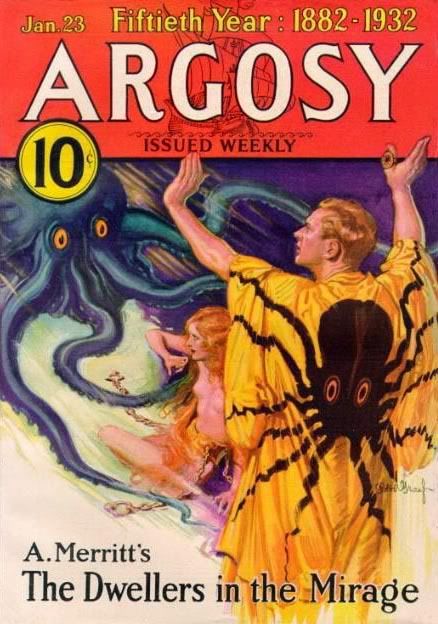
Poulpe Pulps
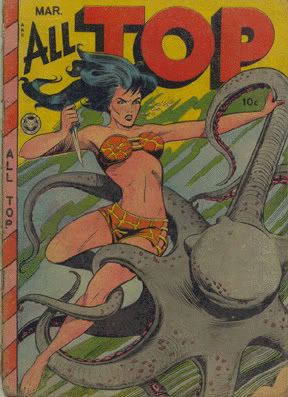
Mis recuerdos a Absencito, todo un teórico de la cultura alternativa. Del cual leo que aunque enfermo ha podido trasladarse al Festival de Cine Fantástico de Sitges (yo debería también estar por allí, y no llorando mis penas). Hoy pasé la tarde con Palimp y nos acordamos de él.
Labels: Literatura
Pulpos y música -Pink Floyd-
Published Friday, October 06, 2006 by Spyder.Syd Barret murió hace unos días, según parece la causa ha sido una complicación en la diabetes que padecía en los últimos años.
Labels: Música
El Octopus Magazine
Published Thursday, October 05, 2006 by Spyder.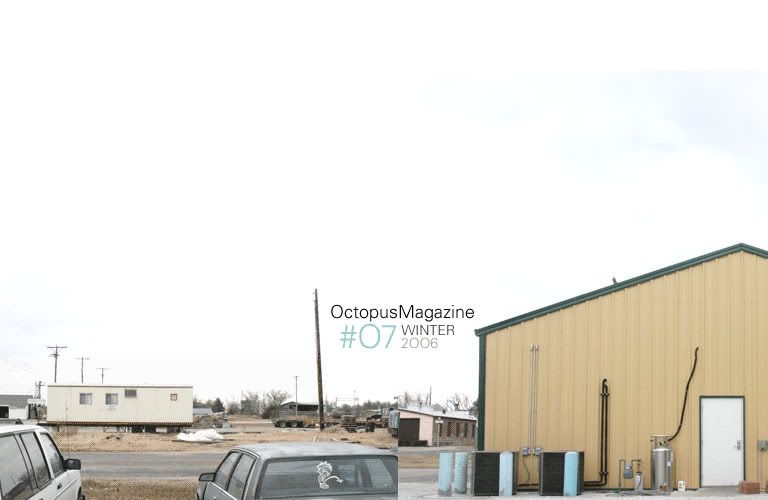
Labels: Literatura
Pulpo caribeño
Published Wednesday, October 04, 2006 by Spyder.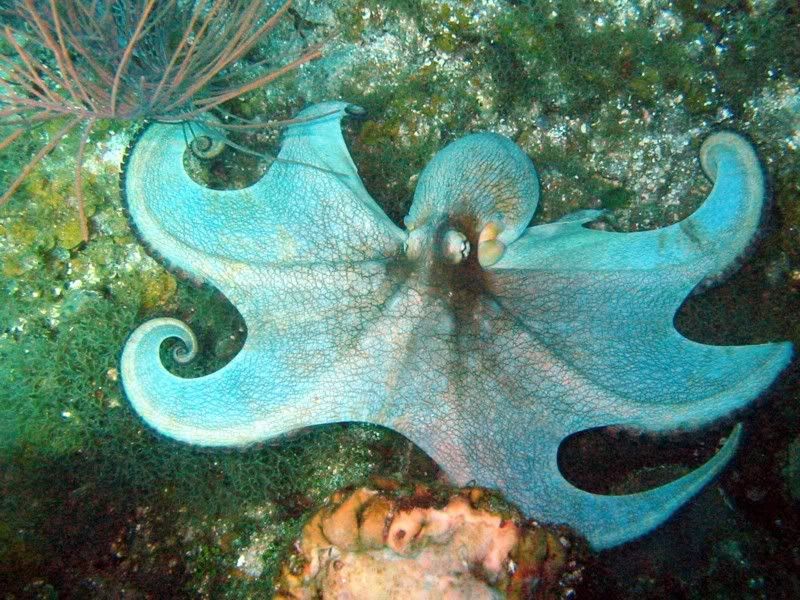
Fotografía tomada en los arrecifes caribeños por Adam Laverty
Labels: Fotografías
Coloreando pulpos
Published Tuesday, October 03, 2006 by Spyder.Cocina -Takoyaki (bolas de pulpo)-
Published Sunday, October 01, 2006 by Spyder.Takoyaki (bolas del pulpo)
Aceite de cocina
Benishoga (jengibre conservado en vinagre) (al gusto)
Cebolla verde (o cevolleta). (al gusto)
Tenkasu (o arroz crujiente) (al gusto)
Pasta para rebozar
450cc de agua
1 pedazo de konbu (quelpo) de 10 cm.
15g de katsuobushi molido (bonito seco raspado)
200g de harina
2 huevos
Salsa
Salsa comercial del takoyaki
O salsa Perrins
O salsa Bull-Dog
O mayonesa
Tiempo de preparación: : 10-20 minutos
Se sirven 50-60 bolas para 4-5 personas
Takoyaki ("bolas del pulpo") se sirve generalmente en los tenderetes de la calle, pero también se puede hacer en casa. Sin embargo, ayudará que usted tenga una parrilla para takoyaki, o un dispositivo similar con las copas de tres centímetros de diámetro.
Preparación de la pasta
1. limpie el konbu limpiándolo ligeramente con un paño.
2. Corte el konbu en tiras de 2 cm de ancho
3. Agregue el agua y el konbu a una olla, y sin taparlo póngala a fuego lento.
4. Momentos antes que el agua comienza a hervir, quite el konbu de la olla. El líquido debe tener un color amarillento o ligeramente verdosos
5. Agregue el katsuobushi raspado cuando al agua comience a hervir.
6. Después de que el líquido haya estado hirviendo un minuto o dos, apague el fuego.
7. Quite rápidamente el katsuobushi raspado del líquido con un filtro o un tamiz o un paño. Intente quitar el katsuobushi mientras que todavía está flotando en la superficie, antes de que tenga una ocasión de hundirse.
8. Permita que el líquido se enfríe, después agregue el líquido, la harina y los huevos a un tazón de fuente y mézclelo.
Preparación del takoyaki
Hacer una hornada pequeña para probar como salen las bolas de takoyaki 4 o 5 al principio, para comprobar la consistencia de la harina.
Agregue más harina o agua según lo necesitado.
1. Ponga aceite en la cacerola del takoyaki.
2. Agregue los pedazos del pulpo cortado a cada copa.
3. Vierta adentro la pasta rebozada.
4. Agregue el benishoga, el negi y el tenkasu al gusto.
5. Cocine los pedazos del takoyaki hasta que alcanzan el grado deseado de firmeza, dándoles la vuelta con frecuencia.
6. Sáquelos de la cacerola y sírvalos con la salsa y/o la mayonesa.
Fuente: Robb Satterwhite y Kenji Mitsuyama
Labels: Gastronomía, Recetas
